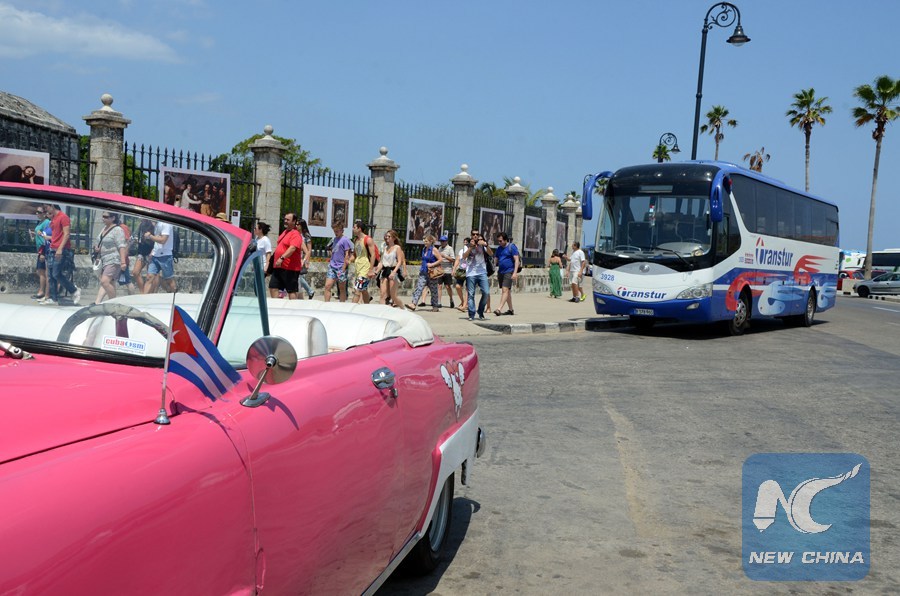
Image taken on April 14, 2016 shows tourists visiting Old Havana, in Havana city, capital of Cuba. (Xinhua/Joaquín Hernández)
By Raimundo Urrechaga
GUARDALAVACA, Cuba, July 6 (Xinhua) -- The thawing of the Cuba-U.S. relations is giving a boost to tourism of the Caribbean island known for its crystal clear sea, white sand, vintage cars, mojito cocktail and cigars.
Now the island wants to benefit from this opportunity and fully develop its tourism by diversifying the destinations beyond the famous Varadero beach and the capital Havana.
The eastern region of the country is looking to attract more visitors with its beaches, rich culture and history as well as Cuba's most impressive mountain range.
Guardalavaca, located in the northern tip of Holguin, has increased its tourism opportunities with top-notch resorts on one of the most exclusive strips of Caribbean beach.
"We love Cuba and this part of the island is exceptional. We've been to many places in the Pacific and the Caribbean but Guardalavaca's beach is spectacular and it's our favorite place," said Jenny Dulovitch, a Canadian tourist who has visited Cuba nine times.
In the high season from November to May, Holguin's resorts are full of Canadians avoiding the freezing winter temperatures and enjoying mojitos and the white sand.
Meanwhile, even in the low season, visitors from European countries like Germany, Britain and Italy as well as Cuban nationals still visit the developing tourist area.
Brisas Guardalavaca, a 437-room four-star resort, attracts visitors from all over the world every year with an all-inclusive service that leaves most of its clients satisfied.
"About 15 percent of our clients come back to the hotel and we thrive in providing a good service as well as updating our rooms, lobby area and restaurants," Yaima Suarez, sales manager at the resort inaugurated in 1994, told Xinhua.
Looking to relax and enjoy the sun of the Caribbean, visitors seem to enjoy Cuba's fourth largest tourist area and its most rapidly expanding beach zone.
"I've come to Cuba 50 times. Guardalavaca is one of the top beaches in the island because of its crystal clear waters and I will definitely come back," said Canadian tourist Clara Sozio.
In Holguin, located 735 kilometers east of Havana, tourists can also enjoy other attractions and activities such as mountain climbing, a visit to Fidel Castro's birthplace or a tour through the island's coal and nickel mines.
The Cuban province currently has 4,000 hotel rooms in over 15 beach and city resorts and Raul Castro's government is looking to build 57,000 new rooms in the next five years, particularly in Guardalavaca.

Cigar enthusiasts smoke at a cocktail gala marking the start of the cigar festival, in Havana, capital of Cuba, Feb. 29, 2016. (Xinhua/Liu Bin)
Havana's detente with Washington is expected to attract more U.S. visitors to the area particularly after direct commercial flights from U.S. were approved last month, although tourist activities in the island are still prohibited by the White House.
"We'll stay loyal with our traditional markets but we're also prepared to receive U.S. visitors in this hotel and any other resort in Holguin," said Suarez.
Flights to Holguin and other eight Cuban cities, except Havana, were already approved by the U.S. Department of Transportation and are set to begin this fall.
"When U.S. visitors start to come more, it would be good for Cuba and it will let them discover an exceptional country far from the image they've got in the past half-century," said Andrea Batista, an Italian tourist in Guardalavaca.
Last year 161,233 U.S. citizens traveled to the island, 76 percent more than in 2014 due to the elimination of restrictions by the Obama administration after the two countries decided to reestablish diplomatic relations.
According to Cuba's Tourism Minister Manuel Marrero, in the first four months of 2016, over 94,000 U.S. citizens had visited the Caribbean island, a 93 percent increase from the same period of 2015.
Air connectivity to Holguin has also increased with flights from various European countries, five Canadian cities and recently a new connection from Panama with Copa Airlines that links the Cuban city with Latin America.
"We see a very promising future and hope that with this new flight the connectivity of Cuba's eastern region would improve," said Claudia Zuluaga, Copa's commercial manager in the Caribbean.
Other cities of Cuba's eastern area, like Camaguey, Baracoa and Santiago de Cuba are also experiencing an important rise in tourism as the industry grows across the island.

